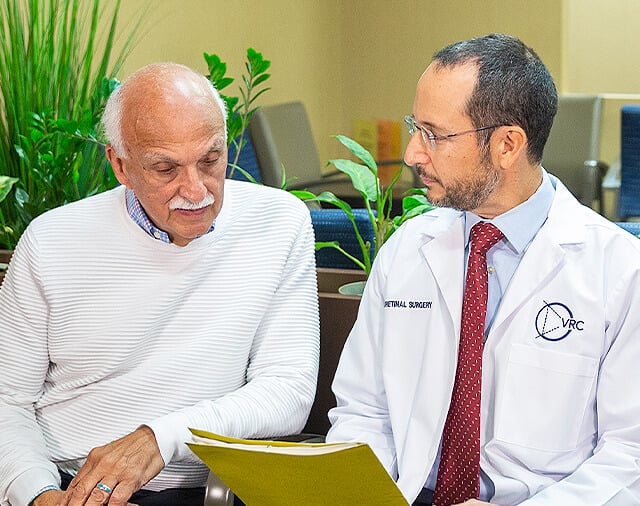Age-Related Macular Degeneration (AMD)

As we age, our macula can deteriorate. This condition is known as age-related macular degeneration (AMD). It is the leading cause of age-related blindness in adults over the age of 50. According to the American Academy of Ophthalmology, this condition affects up to 15 million people in North America.
Learn more about Macular Degeneration from Dr. Fastenberg and Dr. Rosenblatt on the VRC Podcast, Retina in Focus.
Dry Macular Degeneration
The most common form of macular degeneration is dry AMD. It can affect one or both eyes. It is typically painless, but can cause vision changes such as distortions, increased blurriness, decreased sense of color, or the need for brighter light.
Wet AMD
For approximately 10% of AMD patients, dry AMD can lead to a serious form of macular degeneration known as wet AMD. Wet AMD occurs when abnormal blood vessels form in the retina area and leak blood or fluid into the macula, which inhibits the retina’s ability to function properly. In some cases, wet AMD can lead to permanent vision loss.
Choose Vitreoretinal Consultants of NY for AMD in New York
At Vitreoretinal Consultants of NY, we are dedicated to providing exceptional retinal care to patients across the Greater NYC Metropolitan Area, including Queens and Manhattan, as well as Nassau, Suffolk, Rockland, and Westchester counties. For us, nothing is as important as your eyesight. Contact us with any questions, or schedule an appointment with VRC today.
Macular Degeneration Symptoms
In its earliest stages of AMD, there may be no apparent symptoms. However, as the condition progresses, you may experience several changes to your vision, including:
- Blurry vision
- Difficulty reading
- Straight lines appear distorted
- Changes in color perception
- Darkened central vision
How Macular Degeneration is Diagnosed
When being examined for macular degeneration, your doctor will look for the presence of drusen, which are yellow or white deposits of fatty proteins that accumulate under the retina. Small amounts of drusen are a natural part of aging, but the presence of medium-to-large drusen can indicate macular degeneration.
Examining the amount and size of drusen helps retina specialists determine what stage AMD has progressed to. In early macular degeneration, there are typically only small drusen or a few medium-sized deposits, whereas intermediate macular degeneration will be accompanied by either several medium drusen or one large drusen. The presence of large drusen in both eyes increases the likelihood of developing advanced macular degeneration.
There are several diagnostic tests that retina specialists use to determine whether a patient has developed AMD and/or how far the condition has progressed. These tests include:
- Eye dilation: This is an eye exam in which special eye drops are used to keep the pupil open. This exam allows eye physicians to get a better look at the retina, macula, and optic nerve. Eye dilation is a standard part of an annual eye exam and will alert a physician to the presence of drusen.
- Optical coherence tomography (OCT): In this non-invasive imaging diagnostic method, infrared light waves are used to capture cross-sectional images of the retina. OCT helps retina specialists gather information on drusen as well as blood vessels and overall retina structure.
- Fluorescein angiography: This is a test in which colored dye is injected into the bloodstream so that it can migrate to blood vessels in the eye. As the dye travels to the ocular blood vessels, a special camera is used to capture images that will reveal the presence of retinal abnormalities.
- Indocyanine green angiography: Similar to fluorescein angiography, this test also uses an intravenous injection of colored dye and a special camera to capture images of blood flow in the eye. The main difference is the dye used. In indocyanine green angiography, the dye illuminates when exposed to infrared light, making it easier to see the deeper blood vessels in the retina.
Preventing Dry Age-Related Macular Degeneration
Currently, there is no cure for dry AMD. As such, the best way to manage dry AMD is through prevention. Patients should be aware of the symptoms of AMD, as well as the main risk factors associated with it, including age, obesity, high blood pressure, and high cholesterol. Good preventative measures include:
- Getting your eyes examined regularly
- Eating healthy foods
- Not smoking
- Wearing sunglasses
- Maintaining a healthy weight
- Maintaining healthy blood pressure and cholesterol levels
Medications for Wet AMD
There are a few treatment options available for managing the progression of wet AMD and protecting your existing vision, including:
- Focal laser surgery, also known as photocoagulation: In this procedure, a high-energy laser is used to close abnormal blood vessels to stop them from bleeding and causing further damage to the macula.
- Photodynamic therapy: This is a procedure in which a light-activated drug is injected into the bloodstream so that it can travel to the ocular blood vessels. Once the drug has reached these blood vessels, a laser is used to shine a light on the eye and activate the drug, which then seals the abnormal blood vessels.
- Anti-vascular endothelial growth factor (anti-VEGF) medications: This refers to a family of drugs that inhibit the growth of blood vessels in the eye. Common examples of these medications include Avastin, Lucentis, and Eylea. Anti-VEGFs are injected directly into the eye. The eye is numbed before the injection is administered.
Age-Related Macular Degeneration: FAQ
The progression of vision loss in AMD depends on several factors, including the type of macular degeneration (dry vs. wet), other risk factors, how early it was detected, and what preventative measures are taken. In most cases, especially with dry AMD, vision loss is gradual and can be staved off by being vigilant about eye health and making healthy lifestyle choices. However, if dry AMD becomes advanced or transitions into wet AMD, vision loss can be rapid and severe.
Macular degeneration affects your central vision and typically leaves peripheral vision intact. In more advanced cases of AMD, the images you see will be like looking at a photograph that has a dark or blurry spot in the center.
Vitamins and minerals that may reduce the risk of developing advanced AMD include vitamin A, the B vitamins (B6, riboflavin, etc.), vitamin C, vitamin E, lutein, zinc, and copper. However, it’s important to discuss with your doctor first before taking any supplements as some can increase your risk for other complications.
Yes – because it’s the most common cause of age-related vision loss and has no cure, there are many research projects dedicated to exploring treatment options for AMD. Clinical research is an important component of Vitreoretinal Consultant’s practice. We have participated in many clinical trials over the years and are currently recruiting patients for several active trials. Learn more about our age-related macular degeneration clinical trials.
For more information, please visit the American Society of Retina Specialists website.


